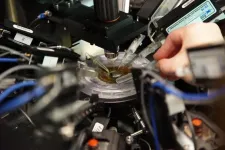Wayne State University partners with Great Lakes Water Authority to help train water pipeline managers of the future
2024-06-04
(Press-News.org) DETROIT — The Great Lakes Water Authority (GLWA) has partnered with Wayne State University to develop its Workforce Development and Pipe Management Program, which will help recruit, teach and graduate the next generation of water pipeline managers. The two-year program will begin July 1, 2024, and will be supported by a contract totaling more than $480,000.
The GLWA says that water utilities are experiencing significant employee recruitment, training and retention challenges. An additional concern is the availability of specialized technical training that addresses recent technological advances in the water sector. In response to these challenges, the Workforce Development and Pipe Management Program (PMP) will form a large-diameter pipe training and research center to address the immediate and long-term needs of the GLWA.
Chris Eamon, Ph.D., professor of civil and environmental engineering at Wayne State University, will be the inaugural director of the program. He will work to develop the program to support its long-term operations and management.
“Ultimately, we want to increase the number of knowledgeable engineers and utility workers in the workforce,” said Eamon. “This will mean fewer failures in our pipeline systems because we will have a larger number of highly skilled professionals maintaining them. It will also mean a more efficient use of the resources that we have. In the last decade, the water sector has seen many retirements, and our infrastructure has had an increased need of trained workers in this area. It’s not just a local problem, but it is a national trend. We’re starting to see significant deterioration in the water supply infrastructure, particularly in areas that were historically under-funded.”
The GLWA owns, operates and maintains more than $26 billion worth of large-diameter pipelines – more than 800 miles of pipes larger than four feet in diameter – that distribute water throughout Southeast Michigan. The GLWA provides water to more than 40% of the state’s population.
“Pipeline systems are the most misunderstood and neglected assets of any utility,” said John Norton, Ph.D., director of research and transformation for GLWA. “It's the sad fact of ‘out of sight, out of mind’ — until they fail, and then everyone is frustrated by the inconvenience until it's fixed, and then it goes back to being completely ignored. We are proud to partner with Wayne State, an outstanding Detroit-centered research institution, to help us develop both the tools and techniques of pipeline management, as well as to recruit, train and graduate our future workforce.”
The PMP will have four primary directives: water industry workforce development, implementation of applied research focused on pipe failures and renewal of legacy pipe; program growth and advancement; and establishment of a large-diameter pipe boneyard facility for education, training, and research purposes.
“The rating from the American Society of Civil Engineers regarding the nation’s infrastructure makes this project of the utmost importance to Michigan and beyond,” said Ali Abolmaali, dean of the College of Engineering at Wayne State University. “Wayne State University’s College of Engineering, in partnership with GLWA, will employ the latest technological developments through this research and education project to address the water infrastructure needs and train professionals in the field.”
“Water is a community’s most crucial resource and Wayne State University is taking steps to ensure our communities have the trained personnel required to improve these systems,” said Ezemenari Obasi, Ph.D., vice president for research at Wayne State University. “I look forward to the important work that Dr. Eamon’s will do with the Great Lakes Water Authority, which will have an impact on our community and state.”
# # #
About Wayne State University
Wayne State University is one of the nation’s pre-eminent public research universities in an urban setting. Through its multidisciplinary approach to research and education, and its ongoing collaboration with government, industry and other institutions, the university seeks to enhance economic growth and improve the quality of life in the city of Detroit, state of Michigan and throughout the world. For more information about research at Wayne State University, visit research.wayne.edu.
Wayne State University’s research efforts are dedicated to a prosperity agenda that betters the lives of our students, supports our faculty in pushing the boundaries of knowledge and innovation further, and strengthens the bonds that interconnect Wayne State and our community. To learn more about Wayne State University’s prosperity agenda, visit president.wayne.edu/prosperity-agenda.
END
ELSE PRESS RELEASES FROM THIS DATE:
2024-06-04
NRG Oncology recently reported the results from the radiotherapy randomization, which was the second step of their NRG-RTOG 0848 clinical study comparing adjuvant chemotherapy with or without chemoradiation for patients with resected periampullary pancreatic adenocarcinoma. The trial data did not show that the addition of radiation and chemotherapy to adjuvant systemic therapy improved overall survival (OS) for all patients on the study, however, OS was improved among node-negative patients. OS was essentially the same between treatment arms for node positive patients. The trial data also showed that disease-free survival (DFS) was improved with ...
2024-06-04
Emma Guttman-Yassky, MD, PhD, Receives High Honor at European Academy of Allergy and Clinical Immunology
The Paul Ehrlich Award for Experimental Research recognizes scientists who have revolutionized the understanding of allergic diseases and immunological mechanisms.
New York, NY (June 4, 2024) – The 2024 European Academy of Allergy and Clinical Immunology (EAACI) Annual Congress selected Emma Guttman-Yassky, MD, PhD, Waldman Chair of the Kimberly and Eric J. Waldman Department of Dermatology, and Professor of Dermatology and Immunology, Icahn School of Medicine at Mount Sinai, as the recipient of the ...
2024-06-04
A team of UC Davis Health researchers discovered that a common anti-inflammatory drug, mesalamine, can replace the work of good bacteria in fighting the nasty fungus Candida albicans in the gut.
C. albicans, or candida, is known to cause yeast infections. In some cases, it develops into invasive candidiasis, a potentially fatal infection occurring mostly in patients with compromised immunity.
The researchers found that this fungus can’t grow without an oxygen supply. Their study in mice showed that the drug can ...
2024-06-04
INDIANAPOLIS – Patients with an intracerebral hemorrhage have better medical outcomes when surgeons perform an early minimally invasive removal of a hematoma compared to those receiving the standard of care, according to a study published in the New England Journal of Medicine.
Indiana University School of Medicine faculty clinicians Mitesh Shah, MD, Bradley Bohnstedt, MD, Regg Singh, MD and Jason Allen, MD, PhD are co-authors ...
2024-06-04
UC San Diego Health is the first hospital system in the region to offer a new immunotherapy treatment for metastatic melanoma. The personalized cellular therapy derived from tumor infiltrating lymphocytes (TIL), is the first solid tumor therapy on the market approved by the U.S. Food and Drug Administration (FDA).
“This one-time cellular immunotherapy is a powerful and robust tool to treat patients with advanced melanoma resistant to other approved therapies and who have limited treatment options,” said Gregory Daniels, MD, PhD, professor of ...
2024-06-04
By Jake Siegel
SEATTLE, WASH.—June 4, 2024—New research by scientists at the Allen Institute’s Brain and Consciousness group and Cedars-Sinai offers an unprecedented look at how neurons respond to ES. Far from being uniform, different types of neurons showed distinct patterns of ‘syncing up’ with electrical fields. These patterns varied depending on the rate at which the ES was delivered.
The findings, published today in Neuron, could help doctors fine tune where, when, and how ...
2024-06-04
Researchers from Indian Institute of Management Calcutta, University of Chicago, and Management Development Institute, Gurgaon published a new Journal of Marketing study that examines the unintended consequences of an Indian government healthcare policy.
The study, forthcoming in the Journal of Marketing, is titled “Do No Harm? Unintended Consequences of Pharmaceutical Price Regulation in India” and is authored by Saravana Jaikumar, Pradeep K. Chintagunta, and Arvind Sahay.
In countries without universal health insurance or developed health care systems, governments try to make drugs affordable and accessible. For instance, ...
2024-06-04
Maternal obesity impacts the eating behaviors of offspring via long-term overexpression of the microRNA miR-505-5p, according to a study publishing June 4th in the open-access journal PLOS Biology by Laura Dearden and Susan Ozanne from the MRC Metabolic Diseases Unit, Institute of Metabolic Science, University of Cambridge, UK, and colleagues.
Previous studies in both humans and animal models have shown that the offspring of obese mothers have a higher risk of obesity and type 2 diabetes. While this relationship is likely the result of a complex relationship between genetics and environment, emerging ...
2024-06-04
Clinicians often default to treating mental health conditions with a variety of medication. This approach, however, largely ignores the role of environment, lifestyle, and social factors. Mental Health professionals must work toward a more holistic management picture, Sidarta Ribeiro, Ana Paula Pimentel, Paulo Amarante and colleagues at the Federal University of Rio Grande do Norte, Federal University of Rio de Janeiro and FIOCRUZ in Brazil argue in the new open-access journal PLOS Mental Health on June 4.
More people than ever are being diagnosed with mental health conditions—particularly children and young adults. The World Health Organization estimates that mental health ...
2024-06-04
Max Chang and Irene Lee of University College London review neuroimaging studies of the effects of internet addiction on adolescent brains. Published June 4 in PLOS Mental Health, the study indicates that internet addiction is associated with disrupted signaling in the regions of the brain that are involved in multiple neural networks. These networks play an important role in controlling our attention, in association with intellectual ability, working memory, physical coordination, and emotional processing—all of which ...
LAST 30 PRESS RELEASES:
[Press-News.org] Wayne State University partners with Great Lakes Water Authority to help train water pipeline managers of the future



